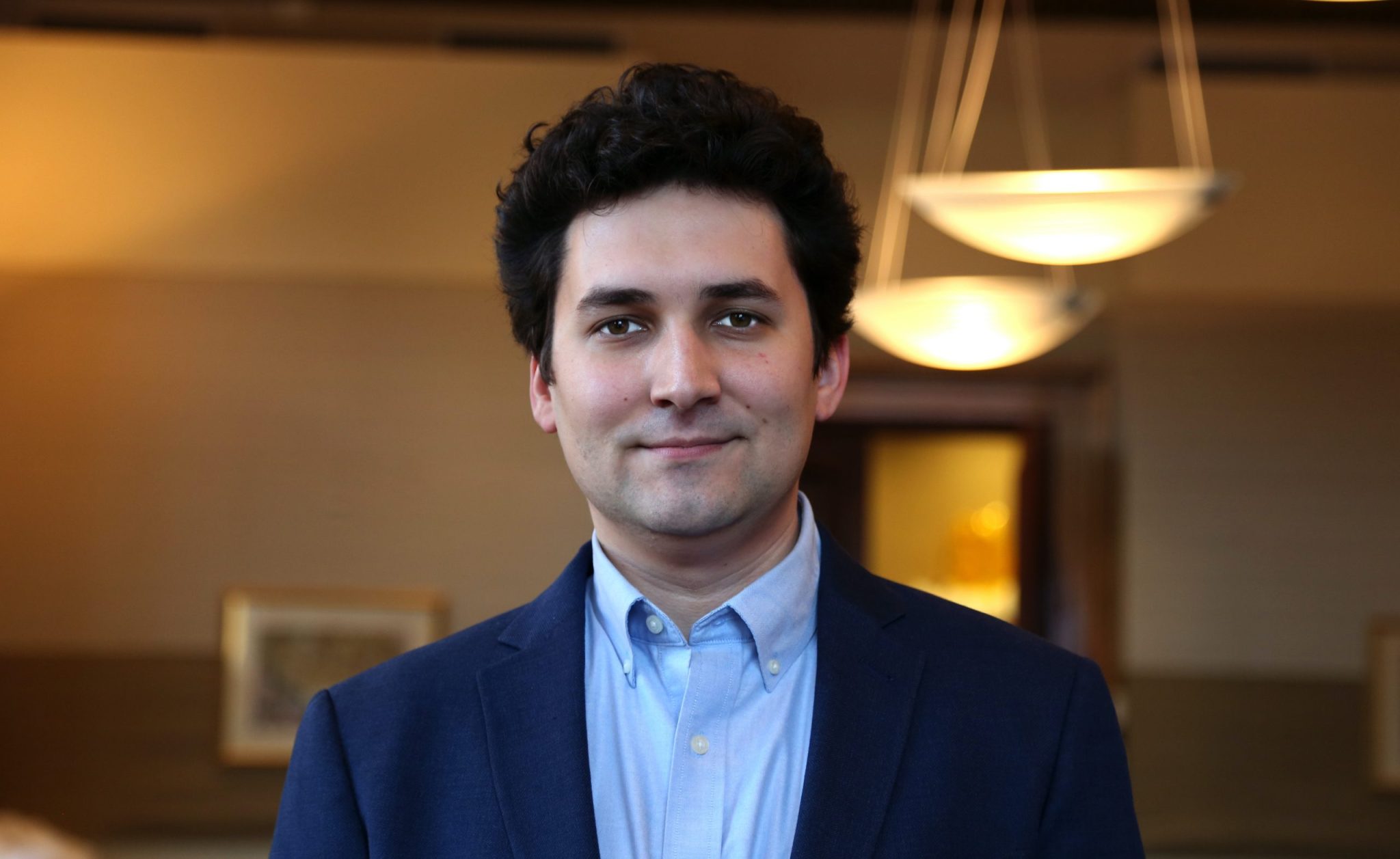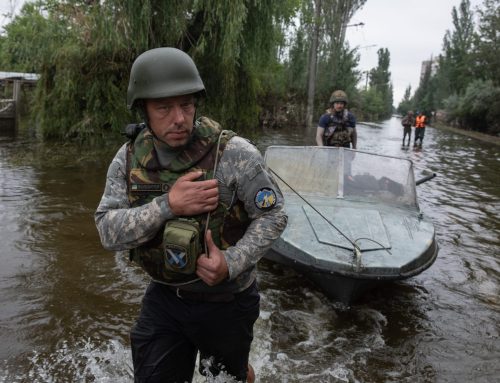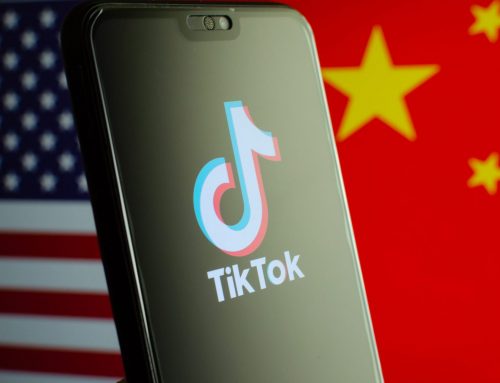Overview
Besides ongoing coverage of the coronavirus pandemic, there was little narrative overlap in messaging from Russian, Chinese, and Iranian government officials and state media, besides the ever-present strain of anti-Americanism. For most of the week, Russia’s messengers covered topics closer to home, with Victory Day celebrations receiving significant coverage, particularly on Twitter. Russian state media also continued to stir up controversies related to Joe Biden and Ukraine, with a series of tweets and articles alleging malfeasance by the former vice president and presumptive democratic presidential nominee. The big news of the week, of course, was the allegation made by The New York Times that Russian military intelligence covertly paid bounties to the Taliban for attacks on coalition forces in Afghanistan. Although much of the Kremlin’s response occurred outside the date range of this report, initial denials followed a familiar pattern, with the Russian Embassy in the United States labelling the report “fake news” and RT calling it a “spy fantasy.” Chinese government officials and state media last week covered simmering tensions with India, but their most aggressive messaging targeted the United States—particularly after President Trump referred to the coronavirus as the “Kung Flu” at a campaign event in Tulsa, Oklahoma. Finally, Iranian messengers continued to criticize the United States over racial and gender-based injustice, while also taking aim at American allies France and Israel. Venezuela also remained a popular topic, with emphasis, as usual, placed on Iranian efforts to support Maduro’s regime in the face of American sanctions.
Russia Toplines
Bombshell allegations that Russian military intelligence paid bounties to the Taliban to kill coalition forces in Afghanistan drew an immediate response from Russian government officials and Kremlin-funded media outlets after the story broke in The New York Times last Friday. Although much of the Kremlin’s response occurred outside the date range of this report, initial denials followed a familiar pattern, with the Russian Embassy in the United States labelling the report “fake news” and RT calling it a “spy fantasy.” Other prominent topics last week were, once again, the pandemic and issues related to systemic racism and police brutality. Additionally, Russian government and diplomatic accounts on Twitter were particularly active in promoting content related to the Victory Day parades that took place around Russia, highlighting both the spectacle of the military parades and standard Kremlin messaging on World War II history. In smaller threads, RT America continued its coverage of statue-related controversies, RT UK posted several videos on UK immigration issues, and multiple Russian state-funded media outlets continued to push allegations of Biden-led U.S. interference in Ukraine.
China Toplines
Although the volume of tweets and associated engagement was down on Twitter last week, Chinese media and government accounts covered a range of issues, from continued tensions with India to the global impact of the pandemic and the National Security Law in Hong Kong. The United States was again the focus of much of China’s messaging, as evidenced by the fact that it was the second-most mentioned country (after China) across messaging on Twitter, YouTube, and state-sponsored websites. As has been the case for the past few months, much of that messaging was highly critical of the United States in general and the Trump administration in particular—especially after the president used the term “Kung Flu” to describe the coronavirus.
Iran Toplines
Last week, Tehran-backed media outlets continued to play up Iran’s collaboration with the United States’ near-peer rivals (Russia and China) and regional adversaries (Venezuela). As usual, many stories sought to cast American global conduct as hypocritical and American society as fundamentally broken. Particular hostility was reserved for American allies like Israel and France, which Iranian messengers rebuked over a Jordan Valley annexation plan and an ICBM test, respectively.
Russian, Chinese, and Iranian state-funded media and government and diplomatic corps accounts:
Top 10 Hashtags — June 13-19:

Countries Mentioned
Top 10 countries mentioned by Russian, Chinese, and Iranian messengers on Twitter, YouTube broadcasts, and state-sponsored websites — June 13-19 (NOTE: there is no broadcast data for Iran):
Twitter mentions:
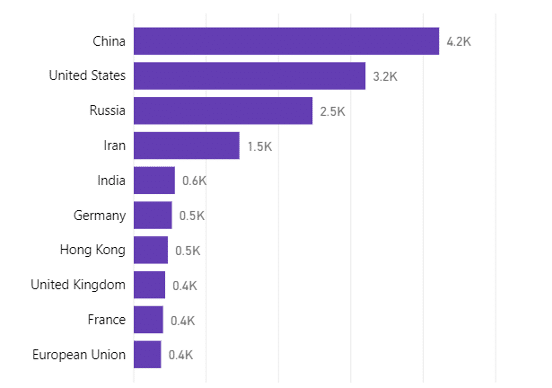
Broadcast Mentions:
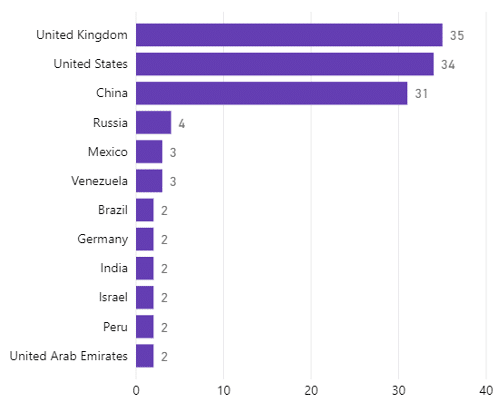
Website Mentions:
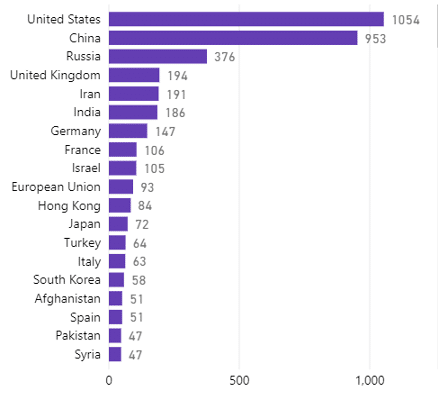
Russia
Kremlin Swift to Deny Afghan Bounty Allegations
On Friday, Russian government officials and state-funded media quickly rebutted reports that Russian military intelligence (GRU) offered the Taliban cash rewards for attacks on coalition forces in Afghanistan. The story was published in The New York Times late in the afternoon on Friday (Washington time), meaning officials in Moscow were likely asleep when the story first broke. The Russian Embassy in Washington therefore provided the first response, blasting The Times for publishing “fake news” and suggesting that the report was another attempt to #BlameRussians:

RT followed suit, labelling the allegations a “spy fantasy” in a quickly penned op-ed by Serbian blogger Nebojsa Malic.

Moscow’s response to the bounty allegations will be covered in more depth in next week’s report, but early efforts to discredit the messenger—in this case the journalists at The New York Times—and label the reporting as “Russophobic” fit a predictable pattern of how the Kremlin responds to negative reporting.
Postponed Victory Day Parades Mark Return of World War II Messaging
Major public events commemorating Victory Day in Russia (May 9) that were postponed due to the coronavirus took place on June 24 (the date of the inaugural Moscow parade in 1945), capped by the main military parade in Moscow. Russia also commemorated what is known there as the Day of Remembrance and Sorrow, marking the start of the Axis invasion of the Soviet Union on June 22, 1941. Much of the coverage highlighted the spectacle of the parades, which featured massive displays of modern military might, along with World War II-era tanks and other callbacks. Like usual, government and diplomatic accounts were at the forefront of pushing this content on Twitter, as can be seen in their most-used hashtags for the week:
Russian government and diplomatic corps accounts:
Top 10 Hashtags — June 20-26:

Aside from the celebratory aspects of this content, coverage also highlighted Russian President Vladimir Putin’s remarks at the Moscow parade, which largely echoed the typical government World War II messaging from his essay the previous week. In particular, he again emphasized the almost inconceivable losses the Soviet Union suffered during the war, characterized the Soviets as liberators of Europe, and cast the Soviets as the primary force responsible for the defeat of Nazism. Earlier in the week, the Russian Embassy in the UK naturally highlighted the part of Putin’s essay that described the UK and France’s signing of the 1938 Munich Agreement, which ceded Czechoslovakia’s Sudetenland to Nazi Germany, as “cruel and cynical,” adding its own paraphrasing:
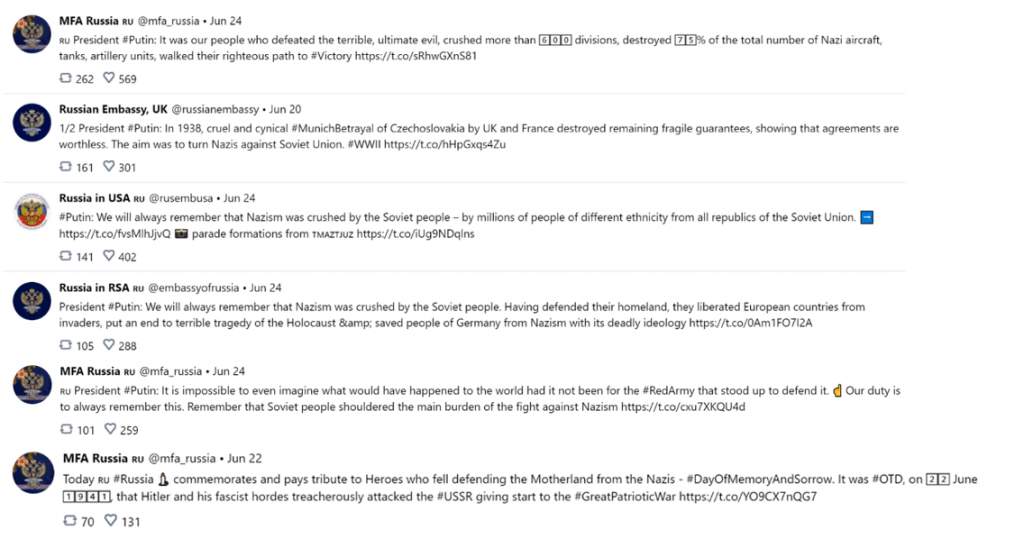
Other outlets picked up on similar themes, along with old standbys such as the contributions of Allied countries. News website TASS often focuses heavily on remarks made by Russian leaders, and last week was no exception; it published several articles on Putin’s World War II remarks throughout the week. TASS also highlighted Victory Day remarks from other world leaders, mainly from the former Soviet Union:
“Putin says memory of WWII absolutely sacred, as Russia marks Day of Remembrance and Sorrow,” TASS, June 22, 2020.
“Russian President Vladimir Putin is confident that the memory of the Great Patriotic War is sacred . . . According to the Russian head of state, the memory of WWII gives one the strength to ‘serve our country, and moral oaths.’”
“Putin says Russia will never forget allies’ contribution to victory over Nazi Germany,” TASS, June 24, 2020.
“Russia will never forget the contribution to achieving the Victory by the Soviet Union’s allies in the anti-Hitler coalition as well as that by all the fighters against Nazism, Russian President Vladimir Putin said during the military parade on Moscow’s Red Square.”
“Kazakh president says heroic deeds of WWII soldiers will always be remembered,” TASS, June 24, 2020.
“The heroic deeds of soldiers killed in the Second World War will always be remembered by the people, Kazakh President Kassym-Jomart Tokayev wrote on Twitter on Wednesday. Tokayev attended the Victory Day parade in Moscow earlier today.”
“Glorious Past and Proud Future: How Russia Celebrated 2020 Victory Day – Video,” Sputnik News, June 25, 2020.
“This year, the Victory Day parade was outstanding in many ways, as the celebration had to be rescheduled due to health concerns. The event was held on 24 June, exactly 75 years after triumphant Soviet soldiers marched through Red Square after defeating Nazi Germany and saving Europe.”
“Watch: What Russian soldiers did with Nazi flags,” RT America, June 24, 2020.
“Russia held a massive military parade on Wednesday to commemorate the 75th anniversary of the Soviet victory over Nazi Germany in WWII. One of the most striking moments of the first ‘Victory Day’ parade was the discarding of captured Nazi flags. The 2020 parade saw an impression demonstration of new military equipment and extra health precautions in place to prevent the spread of COVID-19.”
“Why Russians will never stop remembering WWII Victory Day!” RT America, June 24, 2020.
“Nearly 30 million people died defending the Soviet Union from German invaders during World War II. Rick Sanchez explains the significance. Then RT’s Murad Gazdiev and Saskia Taylor join from Moscow to report on the 75th anniversary celebration, parade and air show commemorating Victory Day.”
Finally, the World War II victory is frequently associated with Soviet nostalgia, and Russia sometimes uses this in its geopolitical messaging, for instance about Crimea. (Note that Ukraine’s response to this tweet received far more engagement, so it is not clear how effective this type of messaging actually is):

Russian state-funded media and government and diplomatic corps accounts:
Top 10 Hashtags — June 20-26:
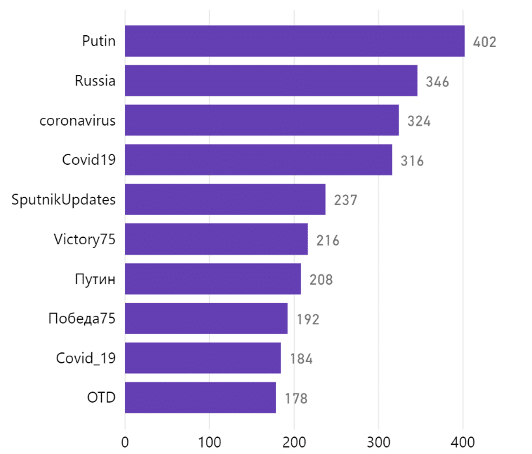
While there were relatively few tweets about the beginning of early voting on changes to Russia’s constitution, RT’s Russian-language account did quote Deputy Chair of the Federation Council Committee on Foreign Affairs Andrei Klimov’s statements (in Russian) asserting that the West is attempting to interfere in the process:

On the topic of foreign interference, multiple state media outlets continued to push the notion that former Vice President Joe Biden orchestrated U.S. interference in Ukraine:



Websites
Russian government-funded websites:
About 14 percent of collected articles mentioned “Covid” in the first 200 words, including the top overall article by Facebook shares:
“Bill Gates says ‘final hurdle’ to distributing a Covid-19 vaccine will be convincing people to TAKE IT,” RT, June 26, 2020.
“Microsoft billionaire Bill Gates lamented the US is ‘not even close’ to doing enough to fight the pandemic, before warning that the vaccine he wants to inject into every human on the planet does require their consent first.”
Other notable articles in the top ten by Facebook engagement covered an apparent misspeak by Nancy Pelosi related to George Floyd, as well as a breaking news article on the Reading terror attack in the UK that repeatedly draws a rhetorical association between the attack and Black Lives Matter, despite noting that police had not found a connection:
“George Kirby bill? Nancy Pelosi FORGETS George Floyd’s name while lauding police reform bill named after him,” RT, June 26, 2020.
“US House Speaker Nancy Pelosi said she was ‘very proud’ to honor the name of ‘George Kirby’ while referring to a House police reform bill named after George Floyd . . . Pelosi recalled Philonise Floyd asking her if he could tell his niece, George’s six-year-old daughter, that his name would “always be remembered” because the bill would be named in his memory.
The House speaker said she would recommend naming the legislation after Floyd, but only if his brother felt it was “worthy” of his name. It was at his point that Pelosi referred to the late Floyd as ‘George Kirby.’”
“Reading attack: Police say ‘no indication’ BLM rally is linked to stabbing attack that killed 3,” RT, June 20, 2020.
“Three people were killed in a stabbing attack at Forbury Gardens, a park in the southern city of Reading, UK. Police have launched a murder investigation into the incident, which took place several hours after a BLM rally. Police have confirmed that three people were killed, and three more suffered injuries in the attack, which unfolded around 7pm on Saturday evening local time, shortly after a Black Lives Matter rally wrapped up at the same site.”
Broadcasts
Russian state-owned media:
The pandemic and various topics related to systemic racism and police brutality continued to receive significant coverage from tracked YouTube channels. Most notable on the coronavirus, RT UK posted a few videos linking the pandemic to the idea of an independent Scotland, including:
“Will Covid cause an independent Scotland?” RT UK, June 24, 2020.
“Will Covid19 be the straw that broke the camel’s back for Scotland? SNP MSP Alex Neil says the growing divide between the Scottish and UK government is showing the country’s changing sentiments.”
Broadcast headlines about statue removals played up the idea that various statues were in danger, though the broadcasts segments themselves were more nuanced:
“Gandhi’s statue! Really? After Columbus & Churchill, Gandhi threatened,” RT America, June 22, 2020.
“UK protesters are demanding the removal of a statue of Ghandi, father of Indian independence. Authorities temporarily had to put protective walls around the statue to protect it from vandalism and destruction.”
“Statue of Abe Lincoln freeing slave now threatened,” RT America, June 25, 2020.
“A controversial statue of Abraham Lincoln and a freed slave symbolizing the emancipation of black Americans and originally paid for by former slaves is now under threat by DC protesters.”
RT UK put out several videos on UK immigration issues, with a focus on the negative human impacts of the hostile environment policy, such as the 2018 Windrush scandal, in which people, many of whom had arrived from Caribbean countries before 1973, were wrongly detained and even deported. A few examples included:
“Was the Windrush scandal accidental? Or intentional?” RT UK, June 22, 2020.
“Was the Windrush scandal accidental? Or intentional? Film maker Jean Marc Aka explains why the answer lies in the initial legislation and subsequent inertia from the government.”
“Windrush: one man’s battle to avoid deportation,” RT UK, June 22, 2020.
“Windrush: the government told this man to return to Antigua – 59 years after he left! And all because of a lost passport. Campaigner Elwaldo Romeo tells his story of battling with the government during the Windrush scandal to avoid deportation.”
“Hostile environment leaving migrants homeless,” RT UK, June 23, 2020.
“‘Everyone deserves a roof over their head, so we’re calling on the government to acknowledge that basic human need.’ Anchor House chief exec Amanda Dubarry explains how the government’s hostile environment towards immigrants is making people homeless.”
Finally, in keeping with Russia’s efforts to project and expand its geopolitical power, RT America highlighted Russia’s push to act as a mediator between India and China:
“Russia to mediate India-China conflict,” RT America, June 22, 2020.
“Twenty Indian soldiers were killed in clashes with Chinese troops in the disputed border region of Ladakh. Russia has stepped in as a potential mediator in the conflict between the two nuclear states. Meanwhile, relations between India and Pakistan remain on edge over the contested Kashmir region.”
China
The United States: More Foe than Friend
In any given week, a substantial proportion of Chinese broadcasts, articles, and tweets captured by Hamilton are highly critical of the United States. Last week was no exception, though messaging was particularly acerbic after President Trump used racist language to describe the coronavirus at a campaign rally in Tulsa, Oklahoma.
State media and associated personnel directly addressed the president’s comments on Twitter:

In a throwback to some of the more memetic content posted by Chinese state media earlier in the year, one of the segments CGTN ran based on President Trump’s “Kung Flu” comment came quite close to calling the President dim: “President Trump says he can’t understand what the ‘19’ in COVID-19 means. The U.S. CDC website explains how the disease was named under ‘Basics.’”
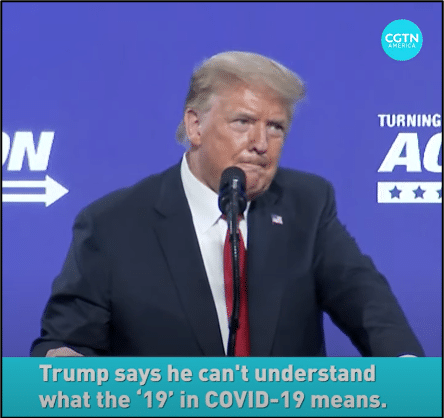
Besides pushing back against criticism of and racist language towards China, state media also went on the offensive in a number of videos that painted a picture of the United States as a dog-eat-dog society where the weak and vulnerable get no protection. In these segments, educators, children, and the elderly were cast as those hardest hit by the inadequacies of the American system:

In line with this idea of a system brutal to those most vulnerable, Chinese state media continued to report on racism and discrimination in the United States. With protests in the United States over the killing of George Floyd subsiding, Beijing has moved toward a more societal, almost anthropological, take on the issue:
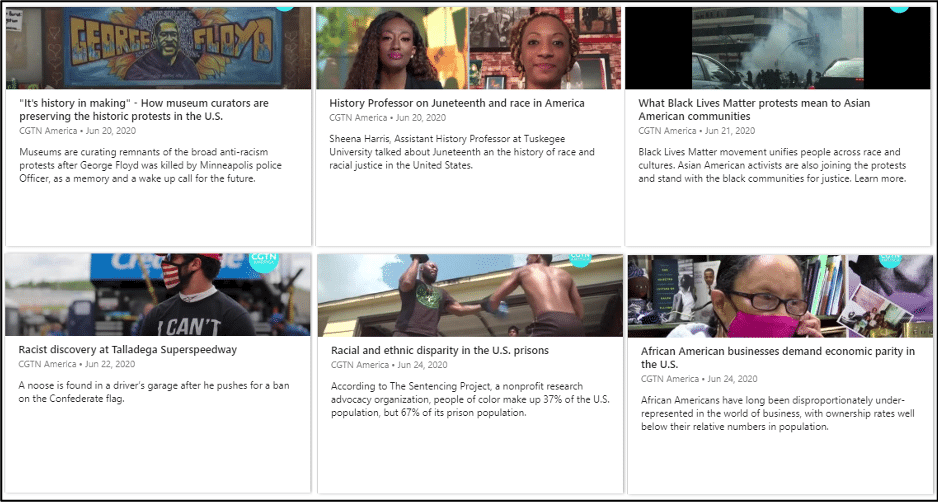
Finally, Chinese Foreign Ministry officials again accused Washington of “double standards” and “hypocrisy,” this time over the decision to designate China Central Television, the China News Service, People’s Daily, and Global Times as “foreign missions”:

Flexing on India
After several soldiers died in a border clash between India and China two weeks ago, there was a fairly robust effort by Beijing to seize control of the narrative surrounding the dispute. Coverage of border tensions continued last week, with #India appearing as the tenth most used hashtag by the Chinese network monitored by Hamilton. However, the relatively low number of tweets featuring the hashtag each day shows that #India’s appearance in the top ten owes much to the relatively low level of activity out of the network last week. By way of comparison, #India was mentioned on average 70 times a day in the latter half of the previous week.

As is often the case, Hu Xijin and his nationalist tabloid Global Times were behind some of the most abrasive takes on the issue:

On Facebook, the lone cooperation-minded story, “China, India hold military talks, agree to take necessary measures to de-escalate tensions,” attracted only a fraction of the engagement of the second most shared state media story on the platform: “Chinese Defense Ministry blames India for border clash: it ‘unilaterally’ violates consensus.”
In that same vein, the only video segment related to the dispute posted on YouTube by Chinese state media last week was CCTV’s “India Should Bear Entire Responsibility for Border Conflicts: Chinese Military Spokesman.”
Chinese state-funded media and government and diplomatic corps accounts:
Top 10 Hashtags — June 20-June 26:

The Hamilton dashboard collected about 14,000 tweets from monitored Twitter accounts between June 20 and June 26. By way of comparison, the same network of accounts posted around 17,000 tweets in the third week of May. Although it retained the top spot, #Covid19 saw an almost 20 percent decrease in its use compared to the previous week.
Chinese diplomatic and state media Twitter accounts also ginned up a mini-controversy last week over an article published on June 17 by the Quincy Institute for Responsible Statecraft, a think-tank in Washington, D.C. The piece criticized many institutions in Washington for not sufficiently disclosing money received from Taiwan. Five days later, the Chinese Ministry for Foreign Affairs and state media reacted:

Websites
Chinese government-funded websites:
On Facebook, the most-shared state media story last week concerned new research on the latest coronavirus outbreak in Beijing, while the fourth-most-shared story looked at how the cold chain—the temperature controlled supply chain used to, among other things, ship food and vaccines—allowed the virus to thrive. Both pointed to the European origin of the strain currently hitting China:
“China CDC: Virus strain from Beijing cluster different from the one in Wuhan,” CGTN, June 26, 2020.
“Genetic analysis from three virus samples showed that virus in Beijing cluster relates to European strain (…) Last week, the World Health Organization (WHO) also confirmed the coronavirus from Beijing’s new local cluster is closely related to the European strain.”
“Has cold chain become the new hotbed for coronavirus?” CGTN, June 21, 2020.
“Recent novel coronavirus clusters reported in Beijing’s Xinfadi wholesale market and Germany’s meat processing firm Toennies seem to point to a new concern (…) Fresh data analysis of gene sequencing has shown that the virus strain that has caused Beijing’s latest outbreak at Xinfadi market has European origins, but is older than the strain currently circulating in the continent.”
Two other highly-shared stories took aim at democratic countries in China’s neighborhood:
“China slams Japan’s renaming of Diaoyu Islands as serious provocation,” CGTN, June 22, 2020.
“The Chinese Foreign Ministry on Monday condemned a move by Japan’s Ishigaki City to change the name of the Diaoyu Islands, calling it a ‘serious provocation on China’s territorial sovereignty.’”
“Mainland calls for cross-Strait unity against ‘Taiwan independence,’” CGTN, June 22, 2020.
“A Chinese mainland official on Monday called for solidarity across the Taiwan Straits to firmly restrain separatist activities advocating “Taiwan independence,” stressing that it is the only way to maintain peace and stability across the Strait and safeguard the interests of Taiwan compatriots.”
Finally, a piece about Egypt intervening in Libya made an unusual appearance in a top ten usually filled with China- or U.S.-centric stories:
“Egyptian president orders army to get ready to intervene in Libya,” CGTN, June 21, 2020.
“Egypt’s President Abdel Fattah al-Sisi on Saturday ordered his army to be ready to intervene in neighboring Libya, if necessary, and said his country has a legitimate right to carry out any mission outside the country.”
Broadcasts
Chinese state-owned media:
At least three broadcast segments promoted China-Russia ties by highligthing Chinese soldiers’ participation in the Victory Day parade in Moscow marking the end of World War II:
“China’s PLA Soldiers Join Russia’s Victory Day Parade,” CCTV, June 24, 2020.
“A total of 105 Chinese PLA soldiers participated in the Victory Day parade celebrating the 75th anniversary of the World War II victory in the Russian capital Moscow on Wednesday.”
“Russia’s V-Day Parade Welcomes Future International Cooperation: Putin,” CCTV, June 24, 2020.
“The Victory Day parade was held to commemorate the sacrifices of people in the World War II, and also convey welcome to international cooperation against the challenges today, said Russian President Vladimir Putin on Wednesday.”
“Chinese Soldiers to Participate in V-Day Parade in Russia,” CCTV, June 23, 2020.
“A total of 105 Chinese soldiers will participate in the Victory Day parade celebrating the 75th anniversary of the World War II victory in the Russian capital Moscow on Wednesday.”
Finally, continuing a theme from the previous week, several video segments highlighted the launch of a satellite meant to allow China to ween off its reliance on GPS. A few examples include:
“China to Build High Precision PNT System with BeiDou by 2035,” CCTV, June 24, 2020.
“China is planning to finish building a high precision national comprehensive positioning, navigation, and timing (PNT) system on the basis of BeiDou system by 2035.”
“China Declares Launch of Last BeiDou Satellite Successful,” CCTV, June 23, 2020.
“China announced Tuesday that the launch of the last satellite of BeiDou Navigation Satellite System (BDS) has succeeded after the Long March-3B carrier rocket sent it to its designated orbit.”
“All Key Components of BDS-3 Satellites Domestically Made: Designer,” CCTV, June 23, 2020.
“China has achieved its goal of having every key component on the BDS-3 satellites 100 percent domestically made, said Xie Jun, the deputy chief designer of the BeiDou Navigation Satellite System (BDS).”
Iran
Familiar Efforts to Cast the United States as Irredeemably Unjust
For the first time since the beginning of June, #BlackLivesMatter was not among the top ten most shared hashtags among Iran-linked Twitter accounts. Nevertheless, several tweets focused on racial and gender-based injustice in the United States, with one editorial cartoon casting the entire country as a slave ship:




Where possible, Iranian media try to use American politicians, journalists, and academics as validators for their criticisms of American society:

Anger at American Allies, Especially Israel and France
Particular ire was directed towards Israel’s proposal to annex portions of the West Bank:




There was also an uptick in coverage of Israel’s involvement in Syria:


Anger towards France focused on a recent test of a nuclear-capable submarine launched ballistic missile. Some commentary condemned the test directly, arguing that it violates the Non-Proliferation of Nuclear Weapons Treaty, the Comprehensive Nuclear-Test-Ban Treaty, or both:



The test seemed to cause an uptick in criticism of France on other subjects as well, across a range of Tehran-backed media outlets:


Highlighting Iran’s Role as a Convener of American Adversaries
As in past weeks, a prominent and popular theme in Iranian media was Tehran’s effort to build solidarity and promote cooperation among U.S. rivals. Discussion of Tehran-Moscow cooperation was down relative to recent weeks, but discussion of Tehran-Beijing cooperation increased. A particular focus was the United States’ role in the Pacific, with Iran casting itself as an important partner of China:


Venezuela also remained a popular topic, with emphasis, as usual, placed on Iranian efforts to support Nicolás Maduro’s regime in the face of American sanctions. In particular, Iranian state-backed media cast news that President Trump might be open to meeting with Maduro as a resounding victory for the “Iran and Venezuela Union of Anti-Imperialism”:
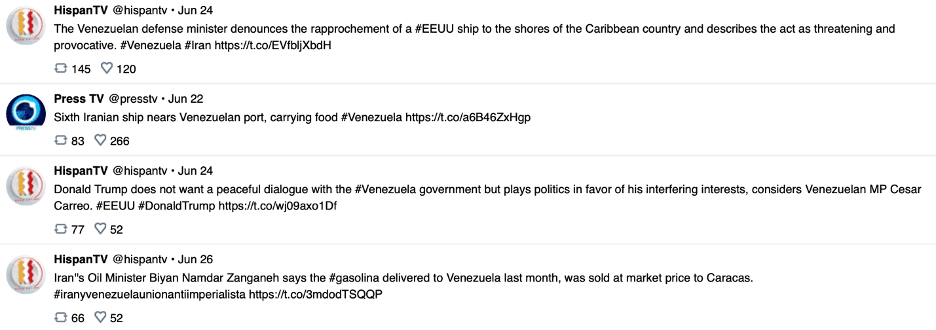



Interestingly, Iranian media favorably reported on successes by the Houthi-led government in Yemen against the coalition led by Iran’s chief regional rival, Saudi Arabia. Unlike the approving coverage of Venezuela’s achievements in the face of American sanctions, however, the coverage of Yemen made no mention of Iranian aid to the Houthis:



Iranian state-funded media and government and diplomatic corps accounts:
Top 10 Hashtags — June 20-June 26:
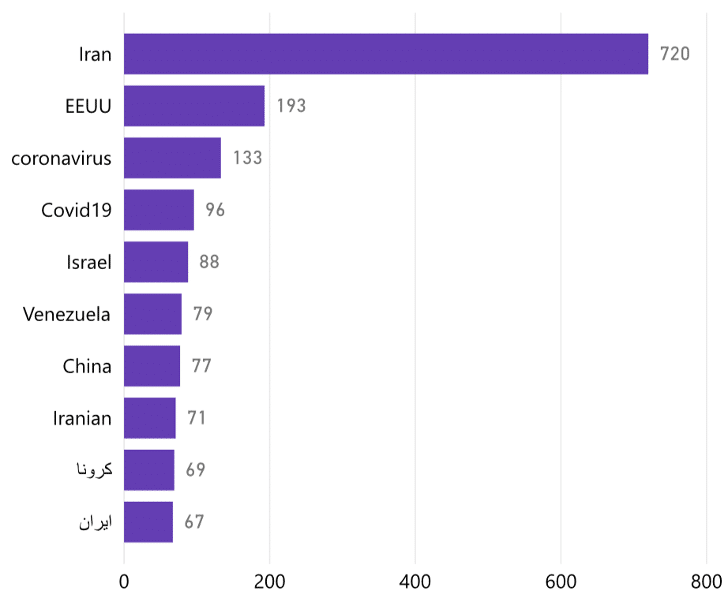
The top ten hashtags from Iranian state-backed media and diplomatic accounts on Twitter reflect the particular emphasis on perceived American imperialism in East Asia and Latin America, as well as ongoing coverage of the coronavirus pandemic.
The two most-liked Tweets came from Mohammed Ghalibaf, the speaker of the Iranian parliament. Both focused on domestic reform rather than international relations.

Websites
Iranian government-funded websites:

The two most engaged-with stories from Iran-backed news websites in the past week focused on Yemeni successes in their conflict with Saudi Arabia. Strikingly, the stories were nearly identical:
“Yemeni forces to strike strategic targets deeper inside Saudi Arabia: Top Houthi official,” PressTV, June 26, 2020.
“Yemen’s popular Houthi Ansarullah movement has praised the latest retaliatory missile and drone strikes on strategic sites deep inside Saudi Arabia, saying Yemen’s army forces and allies are planning to hit more targets in reprisal for the kingdom’s war on the impoverished nation.”
“Yemen on latest raid: All missiles, drones hit intended targets in Saudi Arabia,” PressTV, June 24, 2020.
“Yemen’s Houthi Ansarullah movement has said that all missiles and drones used in the army’s latest raid precisely hit their targets in Saudi Arabia, warning of further strikes on more sensitive locations inside the kingdom if it fails to end the bloodshed in Yemen.”
The views expressed in GMF publications and commentary are the views of the author alone.



